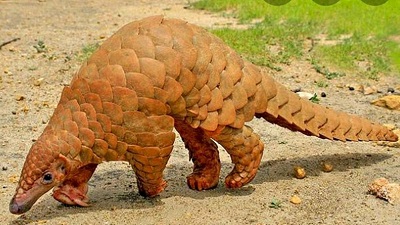Category : Wildlife | Location : Uttar Pradesh | Posted on 2021-08-02 01:14:03

Saturday’s rescue of an adult Indian pangolin, an endangered and elusive mammal, by the forest department from Gautam Budh Nagar’s Behlolpur area has caused quite an excitement, and worry.
The department had found a pangolin near a green patch in Dankaur in June too and later released it in the Hastinapur wildlife sanctuary in Meerut.
The two sightings, a “very rare” event, have led officials to speculate the existence of a “breeding population” in the district.
As per the International Union for Conservation of Nature’s (IUCN) Red List, which is an inventory of the global extinction risk of animals, fungus and plants, the population of the species in the Indian subcontinent is classified as “decreasing”. It also said that there was scarce data on the animal.
Forest officials said that though pangolins are believed to be found around the Yamuna floodplains, they never expected its presence in Noida’s urban forests. “The species is elusive, thus two sightings within two months is very rare. There is a possibility of its breeding population here. We are now vigilant and will also try to mark the areas of its possible habitat within the city. We are delighted that such a rare species exists in our city’s limits,” said PK Srivastava, divisional forest officer, GB Nagar.“The animal rescued on Saturday has been sent to Meerut.”
The pangolins are the most trafficked animal in the world for their scales, according to experts.
India is home to two of the eight pangolin species found across Asia and Africa — the Indian pangolin and Chinese pangolin. According to the IUCN the Indian pangolin is “endangered” and the Chinese pangolin is “critically endangered” — a step below “extinction”. In India, it is protected under the Schedule-1 of the Wildlife (Protection) Act 1972.
With ants and termites its primary prey, the tongue of a pangolin is longer than its body to help it catch thousands of ants per day, the experts said. To protect itself, the mammal rolls into a ball with its tough scale, which is made of keratin (same as human nails), offering protection. “Pangolin” is derived from the Malayan word “pengulin”, which refers to the animal’s unusual defensive posture, according to Wildlife Institute of India. Ironically, it is this same scales that are prized in the international black market.
According to the experts, the species is traded for applications in traditional Chinese medicines.
“The area around Noida is dry and arid, which is where a pangolin could be expected to be found. However, its spotting is definitely a surprise. It is highly prized in the Chinese black market and poached quite widely. It’s very important to raise awareness about this species for its existence,” said Dipankar Ghosh, director (species and landscape), World Wildlife Fund (WWF).
“Pangolin is the world’s most trafficked animal. The species prefer habitats with rocks and boulders under which they dig resting burrows while the location of feeding burrows largely overlaps with the distribution of prey species. In Noida, we believe that it must have ventured out either due to rains or in search of food,” said Sipu Kumar, researcher at Wildlife Institute of India (WII).
The experts also pointed out that there is now a need to focus on microhabitats in Noida.
“It’s very exciting to have spotted pangolin in Noida. There is a possibility of a breeding population in the region, but there is also a possibility that they might be last of the pangolins. There is, thus, an importance to develop and preserve micro-habitat in urban spaces for the co-existence of the species in the region,” said Kartick Satyanarayan, co-founder and CEO, Wildlife SOS, an animal rescue and rehabilitation organisation.
Source: https://www.hindustantimes.com/cities/noida-news/pangolin-was-rescued-in-june-too-foresters-speculate-breeding-population-in-noida-101627842862263.html